Screening and assessment of early language skills is important for every young child. For dual language learners (DLLs), it’s especially critical that reliable language assessment happen regularly, since it can be more difficult to distinguish DLLs who are typically developing from those who have language and communication disorders.
In today’s post, we’re spotlighting 4 helpful resources for accurately evaluating the language development of dual language learners: two recently published books, a new screener, and an assessment. Together, these resources give you up-to-date guidelines on assessment and the reliable tools you need to check the language progress of DLLs.
RECOMMENDED RESOURCE #1
Dual Language Development & Disorders
A Handbook on Bilingualism and Second Language Learning, Third Edition
By Johanne Paradis, Ph.D., Fred Genesee, Ph.D., & Martha B. Crago, Ph.D.
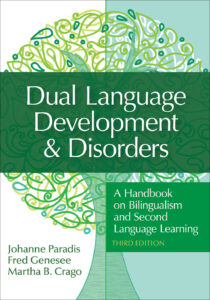 Aligned with Head Start guidelines on cultural and linguistic responsiveness, the third edition of this bestselling book was developed by three influential experts on bilingual language development and updated with the latest research and recommended practices.
Aligned with Head Start guidelines on cultural and linguistic responsiveness, the third edition of this bestselling book was developed by three influential experts on bilingual language development and updated with the latest research and recommended practices.
IN THE AUTHORS’ WORDS:
“Our primary goal in this book is to provide information on typical dual language development, but at the same time, we discuss the implications of various aspects of typical dual language development for the decision making of educators and clinicians regarding referrals, language assessments, and educational programming. Our secondary goal is to provide information about dual language children who might have language, communication, or reading disorders to people who care for these children so that they can understand these children better and, in turn, provide them with additional support.”
ASSESSMENT-SPECIFIC CONTENT:
Information on and considerations for assessment are woven throughout the book, but the book’s final chapters deal with assessment in greater depth. Assessment topics covered include:
- guidelines for choosing a battery of assessments that will reveal the big picture of language development
- tips on effectively gathering information about a child’s language exposure and use
- the benefits of both parent reports and standardized tests
- strategies for improving assessment accuracy
- specific issues to be aware of, including specific for internationally-adopted children and socio-cultural context issues in testing
- considerations to keep in mind when interpreting assessments
- a clear explanation of key concepts that are important for measuring children’s performance, such as normal curve, normal range, percentile, and standard deviation
- use of multi-tiered approaches in which assessment results inform intervention
RAVE REVIEW:
“The authors once again provide current, clear, and accessible information in a culturally responsive manner. Through interwoven discussions of research, educational and clinical contexts, and illustrative case examples, they skillfully build both a theoretical and practical understanding of the heterogeneous nature of dual language learning and how to support dual language learners with different experiences and ability levels.”—Elizabeth Kay-Raining Bird, School of Communication Sciences and Disorders, Dalhousie University, Halifax, Nova Scotia, Canada
Watch a webinar with the editors of this book—learn what’s new in the latest edition and hear about the latest research findings on DLLs!
RECOMMENDED RESOURCE #2
Bilingual Language Development & Disorders in Spanish–English Speakers, Third Edition
Edited by Brian Goldstein, Ph.D., CCC-SLP
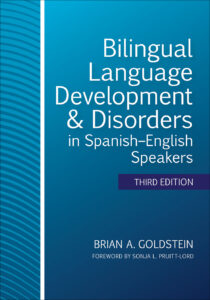 Updated with the latest research, recommended practices, and new chapters on critical topics, this book prepares SLPs for practice with necessary information on language development and disorders of Spanish–English bilingual children. More than 25 leading researchers compile the high-level knowledge SLPs need to work effectively with bilingual learners.
Updated with the latest research, recommended practices, and new chapters on critical topics, this book prepares SLPs for practice with necessary information on language development and disorders of Spanish–English bilingual children. More than 25 leading researchers compile the high-level knowledge SLPs need to work effectively with bilingual learners.
IN THE EDITOR’S WORDS:
“The book bridges the gap between research and practice by summarizing what we know about communication development and disorders in Spanish–English bilingual children and relating it to implications for assessment and intervention…Because the authors of each chapter have provided a link between the research they recount and assessment and/or intervention, SLPs should be able to relatively quickly utilize this information in their clinical practice. In turn, these practices will lead to less biased assessment and intervention for Spanish–English bilingual children.”
ASSESSMENT-SPECIFIC CONTENT:
A key goal of the book is to present assessment best practices within each domain/area of language development (e.g., morphology, syntax, lexicon, phonology). Assessment considerations are woven throughout the chapters, along with guidelines for effective intervention.
Assessment topics covered include:
- the implications of Latino children’s bilingual language experiences for assessment
- a general process SLPs can follow to conduct culturally and linguistically appropriate assessment
- addressing code-switching on the part of a bilingual child during an assessment
- major considerations for bilingual lexical assessment
- the four key categories of tools for bilingual assessment
- issues associated with assessment of vocabulary and semantic skills of bilingual children
- assessment of morphosyntactic acquisition
- considerations for assessing bilingual children suspected of having a speech sound disorder
RAVE REVIEW:
“Communication is a human right and this book can be used to empower Spanish-English speakers to realize this right. Outstanding scholars have translated research evidence to equip speech-language pathologists to support bilingual children and families. This book is an extremely valuable resource for everyone interested in Spanish-English bilingual children’s speech, language, and communication.”—Sharynne McLeod, Professor, Charles Sturt University, Australia
Click here to view the complete table of contents for this book and read more reviews!
RECOMMENDED RESOURCE #3
Quick Interactive Language Screener™: English–Spanish (QUILS™: ES)
A Measure of Vocabulary, Syntax, and Language Acquisition Skills in Young Bilingual Children
By Aquiles Iglesias, Ph.D., Jill de Villiers, Ph.D., Roberta Michnick Golinkoff, Ph.D., Kathryn Hirsh-Pasek, Ph.D., & Mary Sweig Wilson, Ph.D.
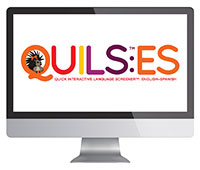 QUILS™: ES is a web–based, game-like screener for probing the language skills of English—Spanish bilingual children. Developed for use with children from ages 3 to 5:11, QUILS: ES measures not only language products (what the child already knows in both languages) but also language processes (how the child learns new words and grammar structures).
QUILS™: ES is a web–based, game-like screener for probing the language skills of English—Spanish bilingual children. Developed for use with children from ages 3 to 5:11, QUILS: ES measures not only language products (what the child already knows in both languages) but also language processes (how the child learns new words and grammar structures).
IN THE DEVELOPERS’ WORDS:
“Being able to understand and talk to teachers and peers is crucial for school success. Although there is agreement among researchers that language skills are essential and serve as the engine for many different types of development, no single test existed that could screen children quickly on different aspects of language, do so without a skilled examiner, and automatically report the scores. With the QUILS: ES, we introduce such a screener, in hopes of reducing the number of bilingual children whose language delays or disorders might not be noticed until they hamper their school performance. Furthermore, identifying bilingual children who might need language remediation before formal school entry may make it possible to offer appropriate intervention earlier, when children can profit most.”
BENEFITS:
- Measures what’s important. QUILS: ES screens key domains of language knowledge that predict a young child’s later academic success.
- Offers a full picture of language development. The language skills of bilingual children are distributed across the two languages they’re learning. That’s why QUILS: ES measures performance in English and Spanish separately and uses best performance—so you’ll have a complete picture of your students’ language skills.
- Compares bilingual children to their peers. Because QUILS: ES compares a child’s progress to that of other young children exposed to both English and Spanish, it’s sensitive enough to pinpoint potential language delays and difficulties in bilingual children.
- Expert-developed, research-based, culturally neutral. QUILS: ES was normed on bilingual English–Spanish students. All items were chosen by child language development experts and based on current research. Native Spanish-speaking experts of the most common Spanish dialects spoken in the U.S. evaluated each item on the screener to reduce bias for any specific dialect.
- No need to be fluent in Spanish. The adult supervising QUILS: ES doesn’t need to be a Spanish speaker. The narration and instruction to the student are in Spanish, but instructions for the supervisor are in English, and each section of the screener progresses automatically unless the supervisor pauses it.
- Fun and engaging for kids. With its interactive items and cute cartoon illustrations, QUILS: ES hooks young children’s attention.
Learn more about QUILS: ES at the dedicated website, where you can download case studies, excerpts from the reports, technical data, and more!
RECOMMENDED RESOURCE #4
Bilingual English-Spanish Assessment™ (BESA™)
By Elizabeth D. Peña, Ph.D., CCC-SLP, Vera F. Gutiérrez-Clellen, Ph.D., CCC-SLP, Aquiles Iglesias, Ph.D., CCC-SLP, Brian A. Goldstein, Ph.D., CCC-SLP, & Lisa M. Bedore, Ph.D., CCC-SLP
 This assessment specifically responds to the needs of young Spanish-English bilingual children from ages 4 through 6 years. BESA was developed to identify phonological and/or language impairment in bilingual and ELL children—and to differentiate between delays in English language acquisition and true language disorders.
This assessment specifically responds to the needs of young Spanish-English bilingual children from ages 4 through 6 years. BESA was developed to identify phonological and/or language impairment in bilingual and ELL children—and to differentiate between delays in English language acquisition and true language disorders.
IN THE DEVELOPERS’ WORDS:
“Translated tests from English may emphasize forms that are not clinically sensitive in another language. Another challenge in the assessment of bilinguals is that children vary greatly in the amount and kind of experiences they have in each language. It is difficult to know in what language bilinguals should be tested, and if they are tested in both languages, there are few guidelines for combining the results of testing in the two languages. In the development of the BESA, we addressed many of these issues in order to help clinicians make accurate, reliable diagnostic decisions.”
BENEFITS:
- Valid and reliable. There are very few assessment tools for bilingual children, and even fewer that are valid and reliable. BESA answers the call for a bilingual assessment backed up with solid evidence of validity and reliability.
- Culturally and linguistically appropriate. BESA subtests are different for each language; the Spanish subtest isn’t just a translation of the English one. Dialects were taken into consideration—the norming sample included 16 Spanish dialects and 7 regional dialects for English—and items were developed for each language based on the markers, structure, and culture of that language.
- Uncovers the full picture of a child’s language development. Not only does BESA identify language impairments, it also helps you gauge progress in both languages and document a child’s dominant language across different domains of speech and language. This critical information will help you plan interventions and educational programming for bilingual children.
- Flexible and convenient. You can use each BESA component independently or combine them as part of an assessment battery. Choose which component you want to give—you’re not required to administer both the English and Spanish subtests. BESA can also be given over multiple sessions, so you can easily fit it into your schedule.
RAVE REVIEW:
“I highly recommend BESA to any speech language pathologist who works with bilingual populations. BESA is the one assessment that I trust to help me make better clinical decisions regarding my bilingual clients’ presence of a communication disorder…I believe BESA represents the growing demand for tools that more precisely identify communication disorders in diverse populations.”—Xigrid Soto, Ph.D. candidate at University of South Florida
Register to watch an in-depth webinar on how to make the most of BESA!
Use the resources in today’s blog post to conduct accurate evaluation of language development in dual language learners—and inform your next steps. And for more on working effectively with young DLLs—including webinars, a tip sheet, and a guide to working with interpreters—be sure to check out the 10 free resources in this blog post.
Stay up to date on the latest posts, news, strategies, and more!
Sign up for one of our FREE newslettersMore posts like this

5 Ways to Support Language & Literacy Skills in Young Dual Language Learners
August 26, 2021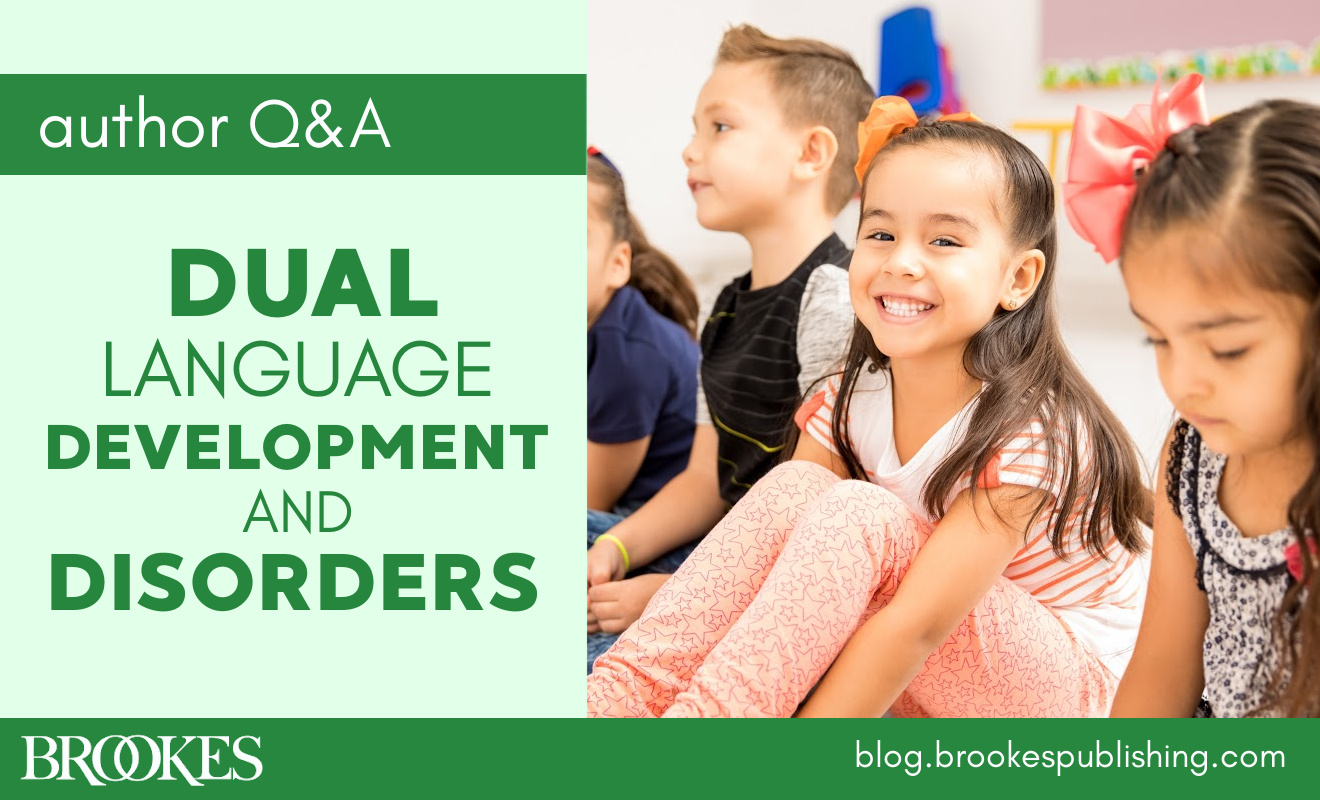
Dual Language Development & Disorders: 7 Questions with 2 Experts
June 29, 2021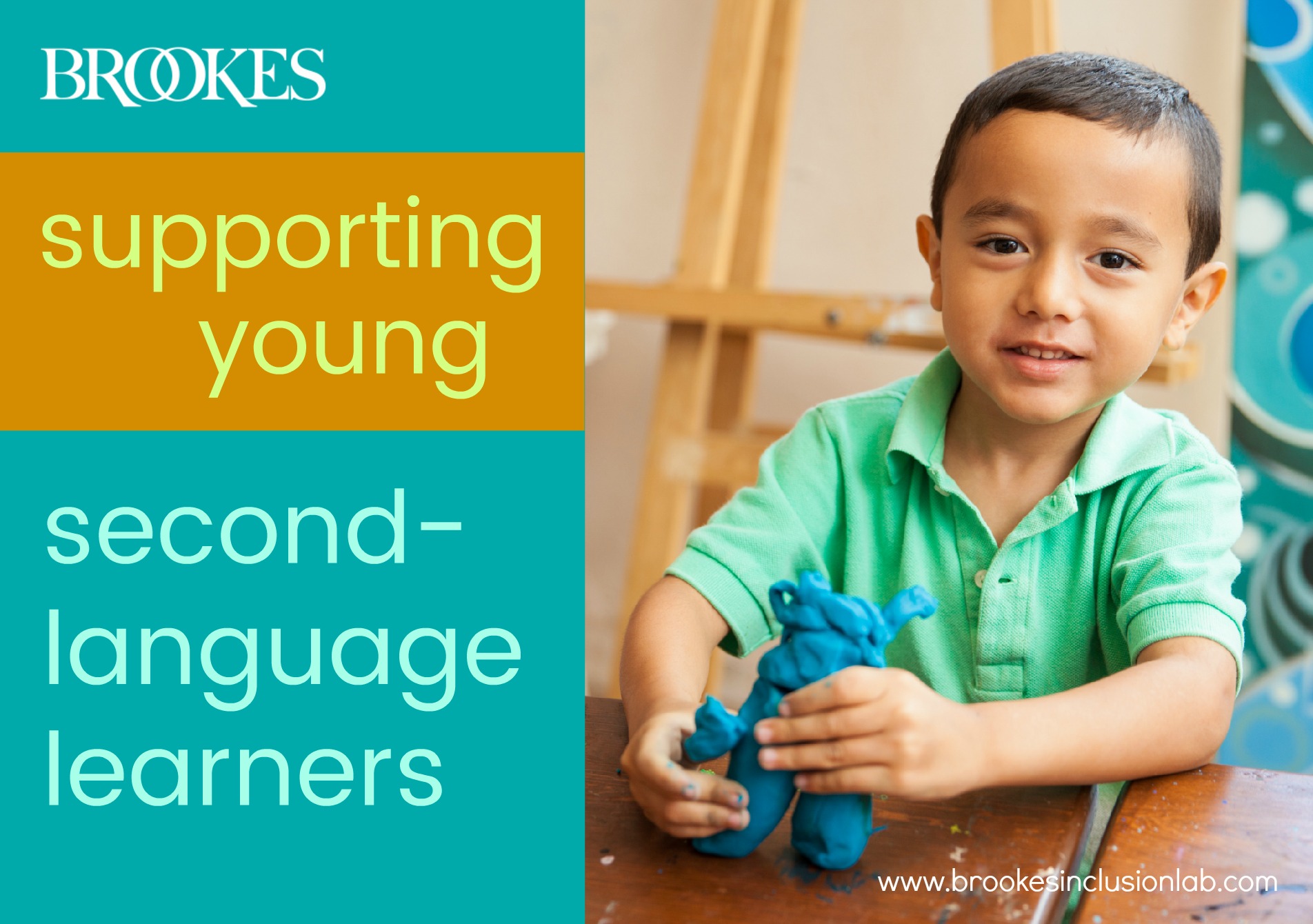

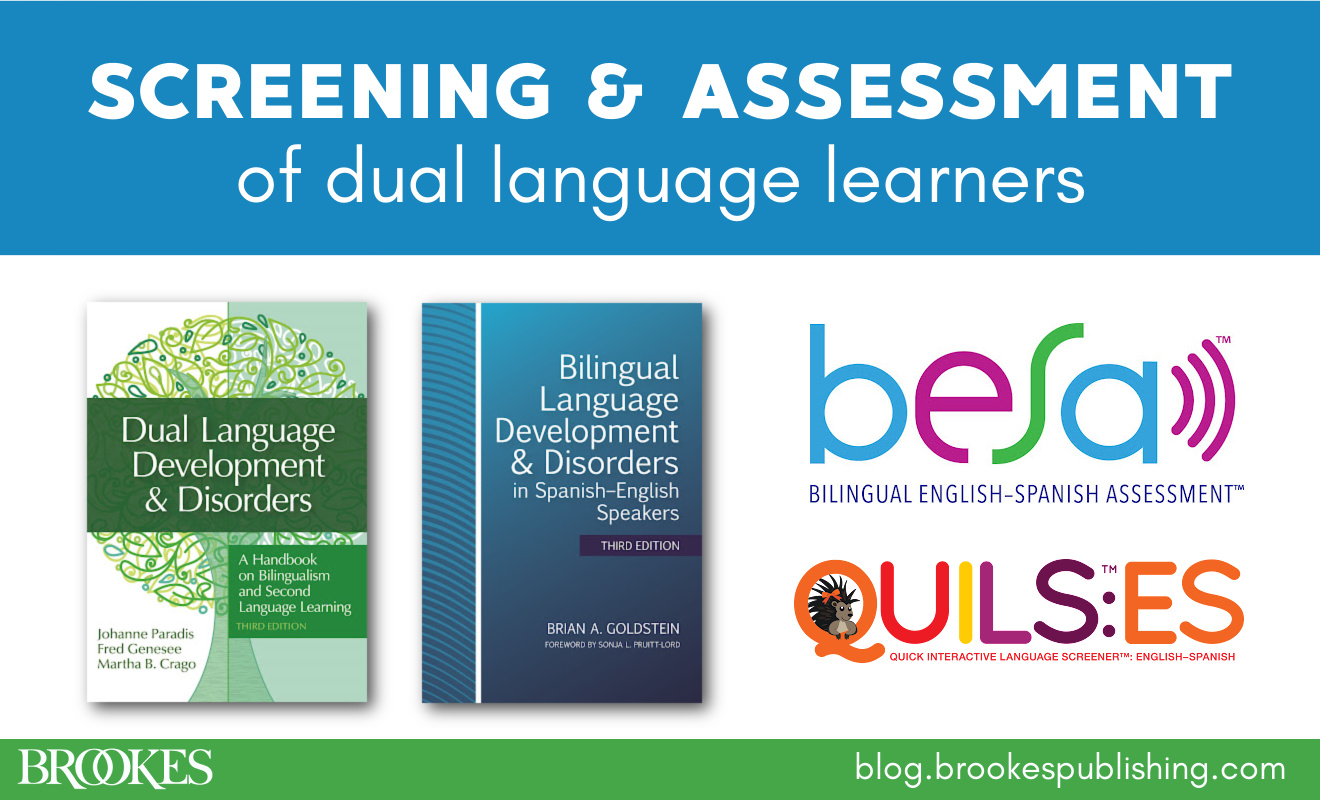
Write a Comment
Your email address will not be published. Required fields are marked *
Post a Comment